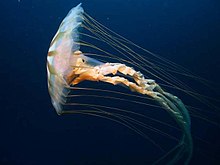
Summary
Chrysaora melanaster, commonly known as the northern sea nettle or brown jellyfish, is a species of jellyfish native to the northern Pacific Ocean and adjacent parts of the Arctic Ocean. It is sometimes referred to as a Pacific sea nettle, but this name is also used for C. fuscescens; the name Japanese sea nettle was also used for this species, but that name now exclusively refers to C. pacifica.[1][2] Although jellyfish kept in public aquariums sometimes are referred to as C. melanaster, this is the result of the historical naming confusion and these actually are C. pacifica.[3]
| Northern sea nettle | |
|---|---|

| |
| Scientific classification | |
| Domain: | Eukaryota |
| Kingdom: | Animalia |
| Phylum: | Cnidaria |
| Class: | Scyphozoa |
| Order: | Semaeostomeae |
| Family: | Pelagiidae |
| Genus: | Chrysaora |
| Species: | C. melanaster
|
| Binomial name | |
| Chrysaora melanaster (Brandt, 1835)
| |
| Synonyms | |
| |
Description edit
The medusa of the northern sea nettle can reach 60 cm (2 ft) in diameter with tentacles growing up to 3 m (10 ft).[4][5] The number of tentacles is up to 24 (three per octant).[1] It dwells at depths of up to 100 meters, where it feeds on copepods, larvaceans, small fish, large zooplankton, and other jellies.[5] The sting is mild, although can cause serious skin irritation and burning.[6] The lifespan is unknown.[7]
Habitat edit
The northern sea nettle is found in open water of temperate northern Pacific Ocean, Arctic Ocean and especially the Bering Sea.[7]
Ecology edit
Pollock can be both the food of the northern sea nettle and also the competitor for potentially limited sources of prey.[8]
Status edit
The total biomass of the northern sea nettle has increased in recent years as climate change has caused a more stable and productive surface layer.[8] This increased stability of the water column would also have contributed to the warmer surface temperatures found in late summer in the 1990s, leading to increased growth and survival of the northern sea nettle.
References edit
- ^ a b Morandini, André C.; Marques, Antonio C. (2010). "Revision of the genus Chrysaora Péron & Lesueur, 1810 (Cnidaria: Scyphozoa)". Zootaxa. 2464: 1–97. doi:10.11646/zootaxa.2464.1.1.
- ^ "Fact Sheet: Japanese Sea Nettle" (PDF). Shedd Aquarium. Retrieved 3 October 2017.[permanent dead link]
- ^ Gaffney, Patrick M.; Collins, Allen G.; Bayha, Keith M. (2017-10-13). "Multigene phylogeny of the scyphozoan jellyfish family Pelagiidae reveals that the common U.S. Atlantic sea nettle comprises two distinct species (Chrysaora quinquecirrha and C. chesapeakei)". PeerJ. 5: e3863. doi:10.7717/peerj.3863. ISSN 2167-8359. PMC 5642265. PMID 29043109.
- ^ CNET news, Chrysaora melanaster, from "Census of Marine Life reveals hidden life in oceans" article (October 5, 2010).
- ^ a b "Sea Nettle: Chrysaora melanaster". Census of Marine Life Arctic Ocean Diversity project. August 20, 2010.
- ^ "Jellies Invasion: Explore Online". National Aquarium in Baltimore. Archived from the original on 16 February 2012. Retrieved 3 October 2017.
- ^ a b "Sea Nettle: Chrysaora melanaster Brandt, 1838". Retrieved 3 October 2017.
- ^ a b R.D, Brodeur (2002). "Increases in jellyfish biomass in the Bering Sea: Implications for the ecosystem" (PDF). Marine Ecology Progress Series. 233: 89–103. doi:10.3354/meps233089.


